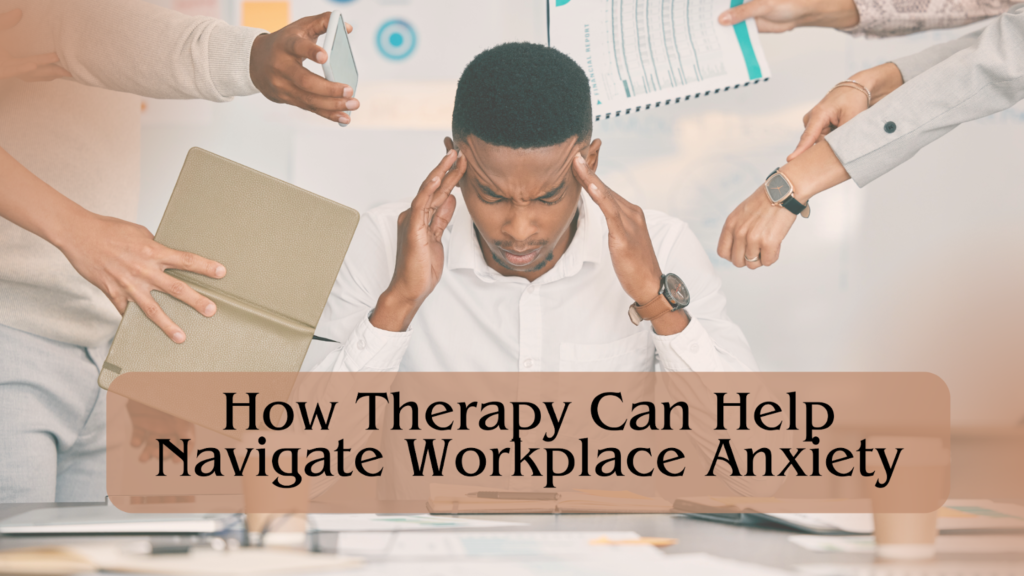Struggling with workplace anxiety? Therapy can be a transformative solution. Many employees struggle with feelings of overwhelm, stress, and worry that can significantly impact their job performance and overall well-being. Workplace anxiety manifests in various ways, impacting both mental and physical health. Recognizing these signs is crucial for seeking help.
Dive into how therapy can empower you to navigate challenges and reclaim your professional confidence.
Understanding Workplace Anxiety
Physical symptoms include an increased heart rate, excessive sweating, tension headaches, and fatigue, while emotional symptoms may involve irritability, difficulty concentrating, and feelings of dread about work.
In places like New Jersey, the high-stress environment of demanding workplaces often exacerbates anxiety, impacting employee productivity and well-being. These anxiety symptoms can significantly affect productivity and decision-making, resulting in a decrease in work performance and increased absenteeism, which costs employers billions annually. For those seeking support, specialized rehab facilities in new jersey offer targeted therapy to help manage and alleviate workplace anxiety effectively
Understanding workplace anxiety’s root causes is essential for effective management. The heavy load of work and deadlines, job insecurity, and even disagreements with co-employees are considered major stressors, perfectionism and self-doubt are personal variables that exacerbate anxiety.
| Did you know?Approximately 40% of employees report experiencing physical symptoms of stress, including headaches and fatigue. |
The Role of Therapy in Managing Workplace Anxiety
Therapy offers effective strategies for managing workplace anxiety. Let’s explore some of the most beneficial approaches:
1. Cognitive-behavioral therapy (CBT)
Cognitive-behavioral therapy is one of the most efficient therapies targeting negative thinking, behavior modification, and acting on those triggers of workplace anxiety. The major techniques are cognitive restructuring, exposure techniques, and stress management techniques. Research has documented that many people can experience a reduction of symptoms of anxiety as high as 60% with CBT.
2. Mindfulness-Based Therapy
These activities have been popularized in an attempt to reduce stress and anxiety. Primarily, concepts forming the basis of such practices concern awareness of the present moment with the acceptance of thoughts and feelings without judgment. Major practices include mindfulness meditation, deep breathing exercises, and body scans. Mindfulness can help most people reduce anxiety by sharpening their focus with constant practice.
3. Solution-Focused Brief Therapy (SFBT)
SFBT offers a very practical approach to dealing with workplace anxiety in that the methodology focuses on solutions rather than on problems. It emphasizes goal setting, finding practical solutions, and utilizing existing strengths. Scaling questions, miracle questions, and identification of exceptions to anxiety are some techniques used that help an individual come up with workable steps they can implement to manage anxiety and improve job performance.
| DID YOU KNOW? A 2022 survey of US employees reported that the most common causes of work-related stress among employees are being overworked and having poor work-life balance. |
Implementing Therapy in the Workplace
The best way to work through workplace anxiety is by seeking the right available therapy services. You can source a therapist through referral from your primary care physician, EAP at your workplace, or online directories. You can go for in-person sessions, online therapy, or workplace wellness. Organizations also offer mental health days off, access to EAPs, and flexible working arrangements.
A supportive environment can be established through the education of managers about mental health awareness, open discussions, and stress-reduction programs. The course of therapy is followed through the establishment of concrete, measurable goals, utilization of anxiety rating scales, and routine follow-up with the treating therapist as well as self-assessment of job performance and satisfaction.
Addressing Common Concerns
Treatment confidentiality is key, and therapists operate under the tightest private laws. It is usually best to avoid any paranoia about privacy at the outset. To reduce stigma, it’s good to educate the workforce about mental health, share stories of people recovering, where clients have been permitted to do so, and show people that it is ok to ask for help – leading by example. In terms of managing therapy sessions, most therapists will accommodate lunchtime or after-work appointments.
Short-term therapies, such as CBT and SFBT, are often resolved within 12-20 sessions. Mindfulness practices can be done within short time frames throughout the day. When considering financial limitations: check your insurance regarding mental health coverage; ask about a sliding scale fee, and utilize workplace EAP programs. Look to community mental health centers, and ask if group therapy may be an option to extend resources.
Conclusion
Therapy can be a powerful tool in navigating workplace anxiety, offering individuals and organizations the means to foster a healthier, more productive work environment. Remember, seeking help is a sign of strength, not weakness.
Prioritizing your mental health is essential for both personal well-being and professional success. Don’t hesitate to reach out for support. Your journey to a less anxious work life begins with a single step!
Frequently Asked Questions (FAQs)
- What are some self-help strategies for managing workplace anxiety?
Self-care techniques for the workplace to deal with anxiety include the use of relaxation techniques, such as breathing exercises; time management, to avoid feeling overwhelmed; goal setting that is not too ambitious; and regular physical activities in life. Other options may include journaling or peer support.
- How can I manage workplace anxiety if I have a demanding job with high-stress levels?
In handling workplace anxiety within a highly demanding job, one would want to focus on prioritizing stress management techniques, maintaining boundaries to help avoid burnout, seeking support from a therapist, and/or researching stress-reduction methods such as mindfulness or cognitive restructuring. One may also want to communicate effectively with supervisors about adjusting workload.
- What role does workplace culture play in anxiety, and how can it be improved?
The workplace culture is one of the major contributory factors in workplace anxiety. This may be supportive and open, which damps anxiety, or it can be toxic, further increasing anxiety. Improvement in workplace culture involves creating awareness about mental health, reducing stigma, sharing discussions on stress, and encouraging a supportive team environment.
- Can workplace anxiety lead to other mental health issues?
Yes, anxiety in the workplace can be associated with other mental disorders such as depression, burnout, and chronic stress. If anxiety is not treated well and is lingering on for a long period, then it may influence the overall mental health of an individual. Thus, early treatment through therapy and support will prevent additional complications.
- What are the signs that my workplace anxiety may require professional help?
Anxiety at work that needs professional intervention might be indicated by some of the following persistent feelings of overwhelming dread or panic about work, disruptions in daily functioning or performance of the job, physical symptoms such as frequent headaches or gastrointestinal problems, and a marked impairment in maintaining personal relationships because of anxiety. Seek professional help if your anxiety is uncontrollable and interferes significantly in your life.







